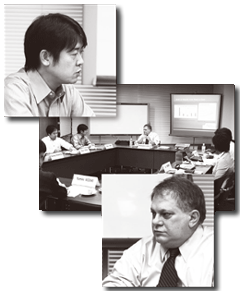Background and Objectives
The Project started from the basic working hypothesis that two major trends in the contemporary international system will continue and accelerate into the future: the “integration” of national economies into
the global economic system, and the “competition” over the redistribution of security-related interests between leading and rising states. In the economic domain, most countries that aspire to maintain the process of
economic integration based on market economy and free trade are likely to play the game according to existing rules of the international economic system. Certain states will be more successful than others in achieving
economic growth and technological advancement, and cause the economic power distribution to change. Consequently, the military balance in various regions will also change, and encourage rising states to assert that
they deserve more security, and demand for the redistribution of security interests as well as the change or modification of existing international rules and norms, and thereby create tension in the security realm.
With regard to the domestic sphere, Japan currently faces obstacles that inhibit its ability to adapt to the changing international environment. Serious domestic challenges ? the ever-expanding social security
budget, the enormous national debt, and parliamentary politics without a center of gravity ? is likely to limit the Japanese government’s ability to mobilize and employ sufficient national security resources and effectively
manage strategic issues that require long-range planning.
What should a Japanese national security strategy in the age of international power transition and national resource constraint look like? This is the central question that we have been tackling in the Project.
In order to address this question, we believe it is necessary to take a two-pronged approach in our thinking of Japanese national security strategy.
First of all, in order to deal with the problem of resource constraints, we need to regain a clear sense of priority for investing in national security. The Project identified threats or potential threats posed
not only to the Japanese mainland but also to its strategic interests overseas that are crucial to its national well-being (we refer to the geographical distribution of strategic interests as “strategic horizon”). Scenarios
were constructed to specify threats, and then these threats were assessed in light of their probability and the magnitude of impact on Japan. The Project distributed questionnaires to Japanese security experts in order
to solicit their expert opinion. Threat assessments based on “probability-impact” analysis will provide a sense of priority by elucidating threats that deserve stronger attention and identifying national security programs
that require priority funding.
Secondly, in order to manage international power transition, we need not only to devise strategies to enhance deterrence and contingency response capabilities (we refer to these as “downstream” strategies),
but we also need strategies to mitigate or alleviate certain structural conditions that might compel some states to take threatening forceful actions (we refer to these as “upstream” strategies). Metaphorically speaking,
in a situation where the amount of water running down the river is likely to increase (power transition), we have to reinforce the downstream dikes and embankments accordingly. However, when our ability to reinforce
downstream structures (defense) is constrained to some extent, we should create branching waterways upstream through a multilateral effort (diplomacy and development), so that the water pressure on the dikes will decrease
? this will ultimately make the dikes downstream more effective. Although the Project believes both the U.S. and Japan will continue to maintain military superiority over others in the next two decades, we will need
creative statecraft that would preventively mitigate structural pressures on rising states whose strategic trajectory is still uncertain.



